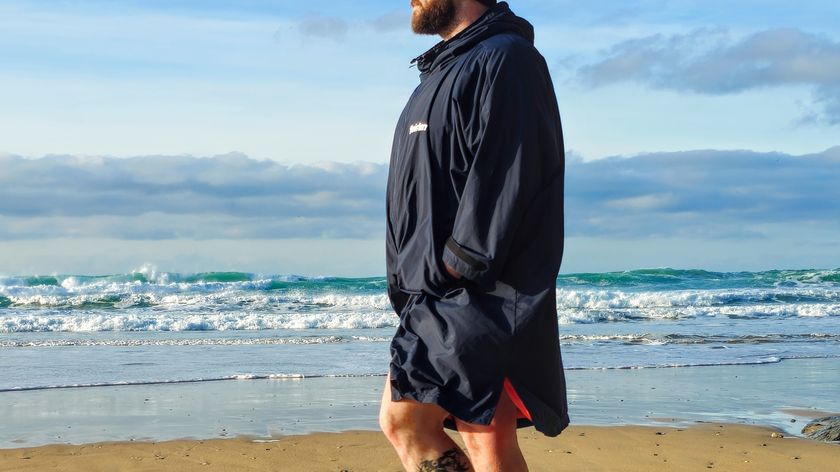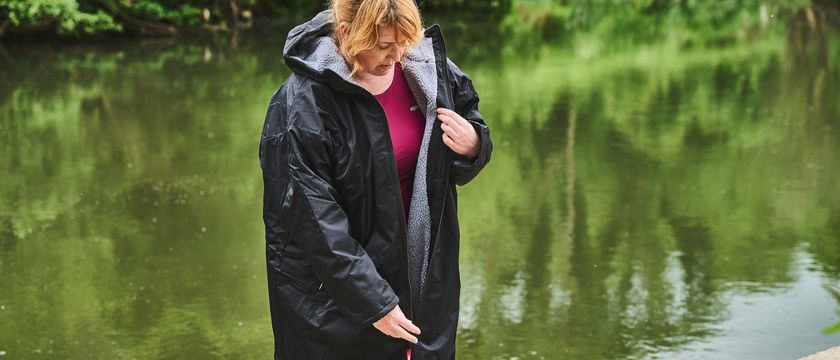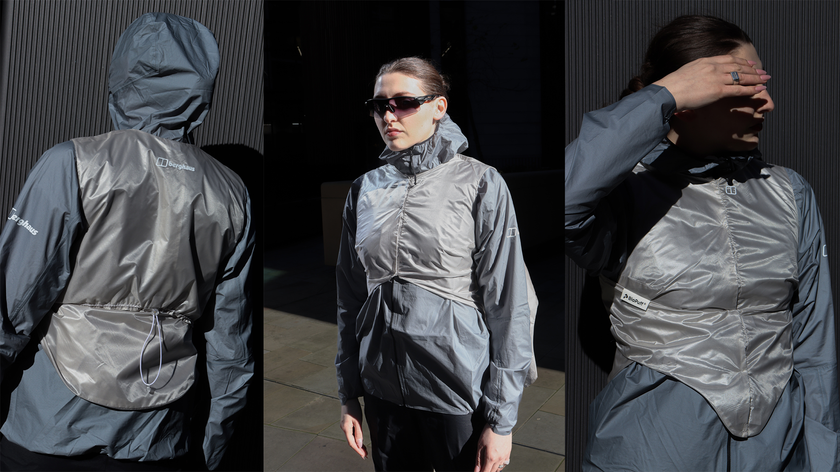The best fishing line: tried and tested lines for every situation
Our expert recommendations on the best fishing lines, including fluorocarbon, mono and braided lines and leaders
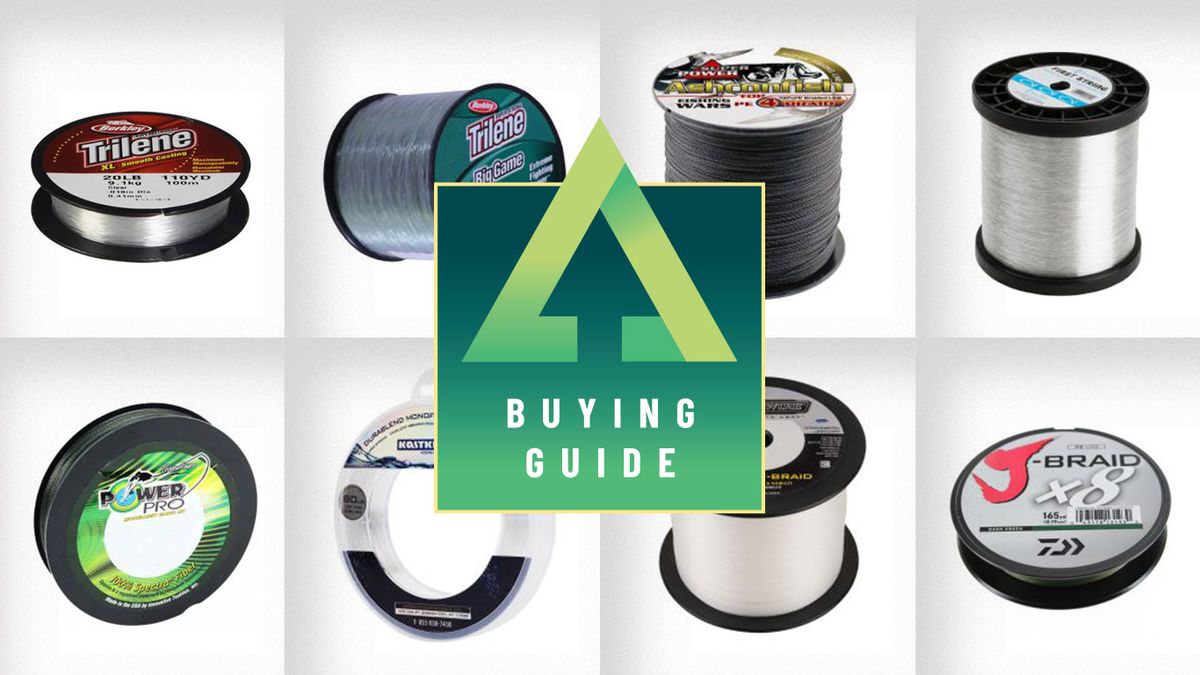
Selecting the best fishing line for the job is crucial. As the only direct connection between angler and fish, a poor choice of line can be catastrophic news for your chances of success but great news for your quarry's chances of escaping.
Go too heavy or too light, or pick the wrong type of line for the job, and you risk a big fat blank or avoidable fish losses due to breakage. And once you've put the effort into getting to the water, you want to be showing your friends that picture of the trophy fish and not be telling them a one–that–got–away story due to using the wrong line.
With this in mind, it’s also important to be smart when it comes to buying the best fishing line. Grabbing the first or cheapest brand you come across and hoping it’s up to the job isn’t ideal. You probably wouldn't use that tactic if you were looking for a reliable new reel or rod, or tyres for your car, and you shouldn't use it when to choose the best fishing line, either.
So, to help you bag that trophy fish, we’ve hand-picked the brands and types of fishing line that we use and love, and we know they’ll work for you too. By the end of this guide, you’ll know enough to choose the perfect fishing line for the job on your next trip to the water – wherever you fish – to maximise your chances of success.
To make it easy, we’ve divided the types of fishing line into three main categories; braided (braid), monofilament (mono) and fluorocarbon (fluoro). We’ve then listed our go-to brands along with our honest review to help you choose the best fishing line available to buy right now for your preferred techniques.
Best braided fishing line
First, we’re going to run through some great choices for braided lines for fishing. Braided line is made of woven strands, often utilising high-tech materials, which result in a very thin and supple fishing line that casts easily and lasts a long time. It can be a bit more expensive than other lines but braid’s longevity often makes it an economical choice over its lifetime.
For example, a mono or fluorocarbon main line might last a season with care, but a braided main line (assuming you don't lose much on snags or tangles) will last two or three times longer. And you can simply reverse the line onto another reel or spare spool, so you get the fresh line that was at the bottom of the old spool sitting on top of the new one. It's like getting brand–new line.
Braided main line usually the go-to choice of main line for anglers fishing in the ocean who want lots of line on a reel, anyone looking to cast a long way, or an angler who wants to feel the bite or fight a little more (braid has no stretch so it’s more direct that stretchy mono line). Casting lures is also really easy with braided main line.
However, braid isn't very good at resisting abrasion from hard surfaces such as rocks, shells, gravel and pilings, so keep this in mind if you're fishing near snaggy areas. Some Bass anglers employ heavy, specialist braids for fishing around weed as it helps to cut and saw through undergrowth.
If you're new to fishing, braid main line maybe isn't the one to start with but anyone with an average amount of experience will enjoy its benefits for many (but not all) styles of fishing. Read on for our choices for the best braided main lines you can spool up with.
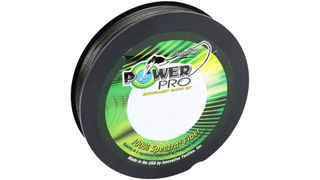
1. PowerPro Braided Spectra Fiber Line
Specifications
Reasons to buy
Reasons to avoid
One of the most respected brands of braided line of all time, PowerPro has been catching fish for years and has a deserved reputation as a reliable option. The high-quality Spectra fibres used in the eight-strand construction, which means it’s woven from eight separate fibres, ensure it’ll last for years and perform well in most conditions. This is the good stuff.
We love the lower breaking strains for general freshwater, surf and boat fishing; 8-15lb for small fish and light line-rated combos, 15-30lb for medium lure and bait fishing applications, 30-50lb for conventional reels, heavier surf and predator fishing and 50-100lb for small to medium-size sharks, big predators and huge catfish.
The Moss Green shade is very subtle and a wise option in 10-20lb for ponds and lakes where clear water makes the bite tricky. The High Vis Yellow has the opposite effect and that’s useful at night, in the ocean, in coloured water or when you need to see what your line is doing.
We’ve used PowerPro extensively and have caught large catfish on the heavier breaking-strains (65lb is a useful strain for use on a big spinning reel) and lots of smaller fish in freshwater and salt on the lower breaking strains with zero issues.
Overall, a classic eight-strand braided line with little to match it for all-round use on a medium budget.
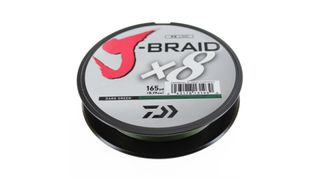
2. Daiwa J-Braid 8-strand
Specifications
Reasons to buy
Reasons to avoid
Hailing from the home of many cutting–edge fishing products – Japan – it’s not surprising that Daiwa’s J-Braid is one of the highest quality and best-regarded braided fishing lines in the world.
Another eight-strand woven main line, J-Braid is a favorite amongst big fish anglers worldwide due to its formidable strength, derived from using extremely high quality fibres tightly woven together for minimum diameter and maximum pulling power. In higher breaking strains, this will land some big fish in freshwater and salt.
Usefully, J-Braid comes in a Multi-Colour option with different shades of braid every ten metres, which allows deep-water anglers to count the depth by noting colour changes in the line as it leaves the reel. This is a great option for anyone looking to accurately target fish at a certain depth – maybe you’re fishing on a boat and notice fish showing on the finder at 50m depth, for example. You can count out ten coloured sections of braid whilst lowering your rig and be at 50m.
This is your go-to braid if you’re looking for the highest quality main line for a medium to large-size spinning or conventional reel to target larger species such as catfish, gars, sharks, tuna, yellowtail, snapper, grouper, jacks and rays.
J-Braid may be a bit pricier than other brands, but with braided line you usually get what you pay for, and the uptick in quality could be a game–changer when it comes to tackling big fish.
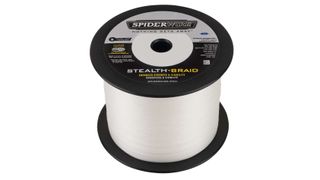
3. Spiderwire Stealth Braid
Specifications
Reasons to buy
Reasons to avoid
Along with poor abrasion resistance, one of the only downsides of braided main-line is its visibility to fish in the water. Enter Spiderwire Stealth and its fluoropolymer coating, which aims to dramatically improve its camouflage properties under water thus not spooking wary fish and getting you more bites.
The coating also makes the braid smoother, which allows it to run through the guides faster and helps you cast further, which is something we could all do with help on. You’ll notice the difference.
Spiderwire Stealth is the braided main line option to go for if you’re targeting smaller species – maybe panfish, small bass, trout, light line surf species like surf perch or whiting – using light spinning or baitcasting combos. You’ll appreciate the extra finesse it’ll afford you when using light tackle and catching even modest-sized fish on 4, 6, 8 or 10lb line is great fun at any age.
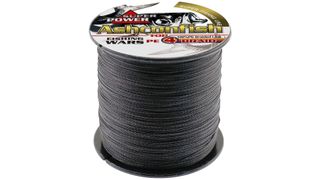
4. AshconFish Braided Fishing Line 4 Strands
Specifications
Reasons to buy
Reasons to avoid
Four-strand braids are often a little cheaper compared to eight-strand versions and they’re a reliable option for many anglers who value durability and cost, due to the price-reducing use of fewer fibres in the construction process. This can be a factor if you’re starting out in the sport and don’t want to invest a lot of money in premium fishing lines but still need a serviceable product.
Ashconfish’s four-strand braid is the best available in this category and works very well on small to medium-sized spinning reels and bait casting outfits for a range of species in fresh and saltwater. Try the 6lb for ultra light surf and freshwater lure fishing; 8, 10, 12 or 15lb for light bait fishing or casting lures and 20-30lb for slightly larger fish like drum, snook, trout, catfish or bass. Spool up with 40–60lb for heavier surf, inshore and offshore species, or 80–100lb for big game missions.
One advantage of the four-strands braid’s rougher surface is that it can cut through vegetation like weeds and grasses easily, which is useful if you’re fishing for bass or catfish near cover.
This is a good option if you’re looking to use braided main lines for the first time, are fishing near weedy cover or anticipate losing some line and rigs in snaggy areas. Re–spooling won't cost a fortune but you'll still get the benefits of using a good braided main line.
Best monofilament fishing line
When most people think of fishing lines, they think of monofilament. This is often clear and looks like a long, thin strand of plastic. Mono line is cheaper than braided lines and is made from a single, extruded piece of line, which also has a good amount of stretch, low visibility and great abrasion resistance.
However, mono fishing line can be a little wiry, doesn’t cast as well compared to braided lines and is thicker than braid, so you can’t fit as much on your spool. But in general, mono is a good all-rounder for main line and leaders – here are our top picks to spool up with.

5. Berkley Trilene XL
Specifications
Reasons to buy
Reasons to avoid
If you’ve recently started fishing or just want a solid all-round fishing line for general species, then it’s likely Berkley Trilene XL mono is a good starting option to spool up with.
First, it’ll perform well wherever you take it – from long casts with a lure for trout or bass, to surf fishing or boat fishing. The tough mono construction also gives it an edge over braid when fishing near abrasive structure – docks, reefs or pilings, for example. It’s economical, too.
For spooling a 2000-4000 size spinning reel to target small to medium size fish – bass, trout or perch for example – try 4–8lb main line, remembering that the lighter mono will always cast further due to its less wiry nature. A spool full of 10–20lb line will tackle some serious lake and river fish or surf species and we like the clear version for most situations. Truly a line for all seasons, species and situations.
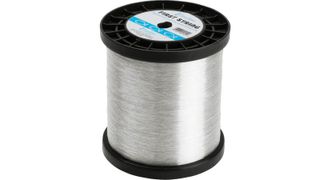
6. Izorline First String
Specifications
Reasons to buy
Reasons to avoid
If you’re an angler who targets big fish, then having a good quality mono leader material in your bag is essential. A mono leader is a length of line tied to your main line (often braid) that can take the abrasion from a fish’s teeth, rough skin, or rubbing against structure like a reef or dock, and its use is sometimes the difference between landing a good fish and losing it due to breakage.
The best mono for this purpose that we’ve found is Izorline First String and we’ve experienced first-hand how well this deals with larger fish and adverse conditions like weed and rocks. Because of its hard construction, it’ll take a lot of punishment before breaking and has great knot strength. It's our favorite mono leader for these reasons.
Check out the 2-8lb strains for a high quality mono main line, 10–80lb versions if you need a good mono leader to attach to your braided main line, and heavier for big game applications such as shark and tuna fishing. The clear is favoured, generally. A legendary line for those in the know.
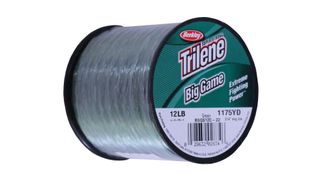
7. Berkley Trilene Big Game
Specifications
Reasons to buy
Reasons to avoid
If you’re the kind of angler who likes catching big fish – catfish, carp, sharks, tuna, salmon, gar, etc – then you’ll need a main line that’s tough enough to cope and one that hopefully doesn’t cost a fortune to spool up a big reel with. Trilene Big Game ticks those boxes and more.
Legendary amongst anglers who fish in snaggy environments for trophy fish, Trilene Big Game really is the best choice of mono main line for anyone who requires maximum durability and toughness above all else. It’s the Terminator of fishing lines – it just doesn't give up, ever.
Try 40, 50, 60 or 100lb for top shots and spooling big conventional reels and lower strains (10–30lb) for spinning reels targeting surf sharks, catfish, muskie, pike, stripers, bass and other hard-fighting fish. The bulk spools are a great way of saving money in the long term and it’s a reasonable choice for a mono leader if a wire leader isn’t required.
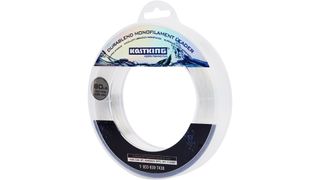
8. Kastking Durablend Monofilament Leader Line
Specifications
Reasons to buy
Reasons to avoid
With the increasing popularity of targeting larger fish from the beach, boat or shore, having a go–to mono leader material on hand is important and we love Kastking Durablend for its ability to be both tough and supple.
The toughness means it can withstand the force of a big cast when used as a casting leader or the sandpaper–effect of a shark’s skin, whilst it’s supple enough to fly through the rod rings smoother than most heavy monos. It knots nicely, too.
Try 60, 80 and 100lb for casting leaders when chasing big fish in the ocean or freshwater, and higher breaking strains to handle rub leaders for big sharks and game fish or bite leaders when wire isn’t required.
This is the number one-selling mono line in the USA and this is for a good reason - it performs well above its price point and is a great all-round mono in all strains.
Best fluorocarbon fishing line
Fluorocarbon line is similar to monofilament, with the main difference being that it’s made from a special material that makes it much harder for the fish to see in the water. This makes it a good option for fishing in clear water or for wary species. It's also heavier and has less stretch compared to mono, but is usually a bit tougher.
Generally, anglers use a few metres or feet of fluorocarbon line at the end of a braided or mono main line to take advantage of this lack of visibility and its great abrasion resistance. Here are a few of our favorite fluorocarbon fishing lines that we consider to among the best fishing lines available to buy right now.
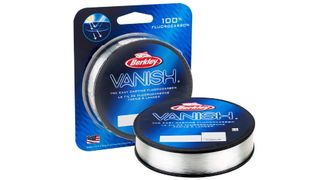
7. Berkley Vanish Fluorocarbon
Specifications
Reasons to buy
Reasons to avoid
Anyone looking for a great value fluorocarbon leader material should check out Berkley's Vanish – a staple of many freshwater and saltwater tackle boxes for many years. It’s made from 100% fluorocarbon rather than being fluorocarbon-coated and comes in handy 110-yard spools starting at a very reasonable price.
A tough fluorocarbon line like Vanish can be just what’s required for a leader to take the force of a fish’s teeth and skin rubbing, especially 40 and 60lb strains when dealing with species like croaker, small sharks, catfish, small tuna and rays.
Try the lighter strains 2, 4, 6 and 8lb for a solid all–round performer in just about any fishing scenario when the invisibility of fluorocarbon is going to be an advantage for targeting small species, with the middling 10–30lb strains ideal for medium–grade fish leaders and traces. We’ve used Berkley Vanish it for years and love it – it won't let you down.
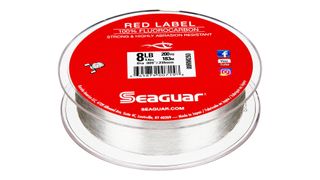
8. Seaguar Red Label Fluorocarbon
Specifications
Reasons to buy
Reasons to avoid
When you’re targeting wary fish and need a supple bite leader to avoid detection, a quality fluorocarbon like Seaguar Red Label is one of the best fishing lines out there. Seaguar are one of the most successful manufacturers of fluorocarbon lines in the world and Red Label is one of their biggest sellers for a reason – it offers a great blend of value and performance that many anglers trust at the business end of their fishing tackle.
We particularly like the lower breaking-strains – 2, 4, 6 and 8lb – for use as bite leaders when fishing for small species like trout, panfish and light line saltwater species like surf perch, croaker, whiting or pompano. In our experience, this line has performed very well in saltwater and freshwater for a variety of species and we’re sure it’s led to more bites with its perfect blend of invisibility and suppleness.
The knot strength is good and it’s highly abrasion resistant too, making a good option for almost any application requiring a subtle leader up to or under 20lb breaking strain. We love it and rarely fish light tackle without a spool in our bag somewhere.
How to choose fishing line
Perhaps the most important part of choosing a fishing line is to match the line to the type of fishing you’re doing and equipment you have. Most rods have a line rating on them – don’t be tempted to go outside of this too much.
Once you know the rod is suitable for your type of fishing, ensure the reel is also a good match and the rod and reel are both either spinning or conventional models so the whole combination, including the line, works well. The reel will have some guidance about how much line it can take printed on the spool – make sure you have enough line to fill the spool properly. It’s no good ordering 300m of 20lb line if the spool needs 400m of 20lb line to fill.
Most tackle shops offer a spooling service and, especially for braid, we recommend you take advantage of this to see how a professional technician loads a reel with line. It's hard to load braided line at home and doing so will often result in extra tangles and issues.
In summary, this fishing line buying guide covers a multitude of lines suitable for a huge range techniques and species – we've tried to cover all the bases to make choosing the best fishing line as easy as possible. As the saying goes, tight lines!
What to do with your old fishing line
Fishing line becomes weak and brittle when used regularly, so it's important to dispose of it properly. Discarded line poses a major threat to wildlife and other water users, and it can't be handled by ordinary household recycling schemes.
In the US, many marinas and boat ramps have on-site recycling bins where you can drop your reels and line. Make sure you remove any hooks and lures beforehand.
In the UK, the Anglers National Line Recycling Scheme (ANLRS) takes old line that would otherwise end up in landfill or incinerated, and sends it to ReFactory, which handles plastics that are hard to process using conventional means, and turns them into usable materials,
Advnture Newsletter
All the latest inspiration, tips and guides to help you plan your next Advnture!
An obsessed fisherman since childhood, Ben’s career in fishing has taken him from working as a magazine writer and editor to running his own guiding business in California, where he targets salt and freshwater fish. Ben has decades of experience in selecting the right tackle and honing the best tactics to target all sorts of species, from surf sharks to freshwater catfish, and loves sharing this knowledge. His favorite fishing moments usually involve helping clients catch the fish of a lifetime – and not getting eaten by great white sharks while out on his kayak.

